Ted Joans
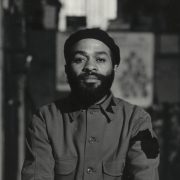

Search for art, find what you are looking for in the museum and much more.
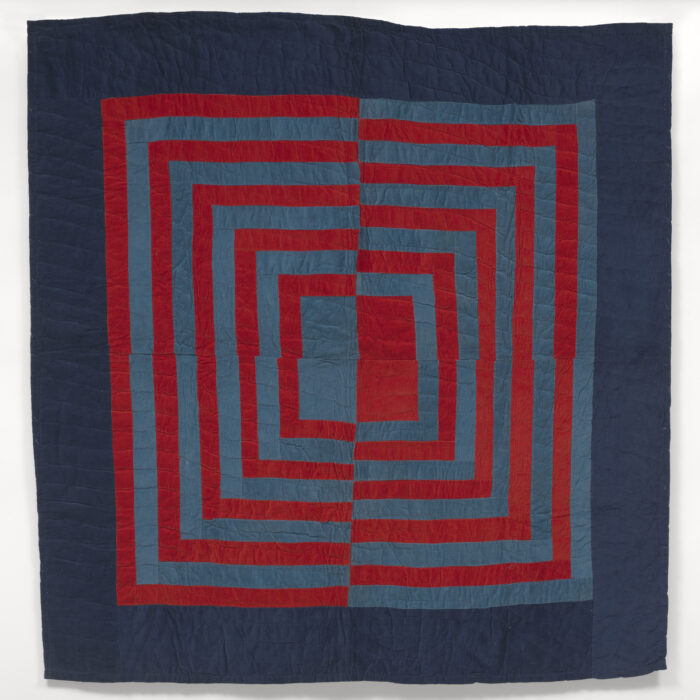
Explore the quilts of Gee’s Bend and discover how they stand out for their flair - composed boldly and improvisationally, in geometric patterns and transform recycled clothes and other remnants into extraordinary works of art.
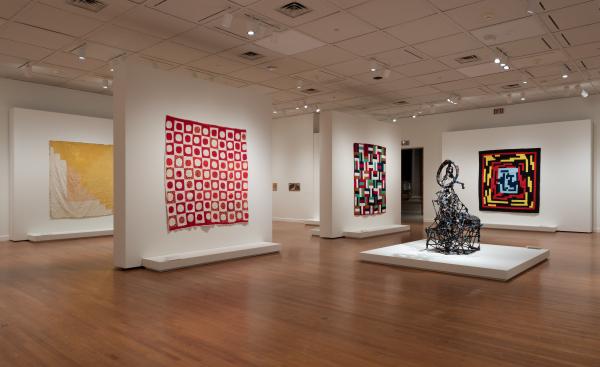 Cosmologies from the Tree of Life exhibition, 2019
Cosmologies from the Tree of Life exhibition, 2019 In 2018 VMFA acquired 34 Artworks from the Souls Grown Deep Foundation including 13 quilts that highlight the artistry of this multigenerational quilt making community, which is renown given their virtual isolation in Gees Bend, Alabama (now Boykin, Alabama). These artworks were displayed in the 2019 exhibition, Cosmologies from the Tree of Life: Art from the African American South. VMFA’s collection of Gee’s Bend quilts is featured in an online exhibition by the Souls Grown Deep Foundation titled 100 Years of Gee’s Bend Quilts on Google Arts & Culture, where you can explore by decades beginning with the 1920s.
(b. 1960)
(b. 1935)
(1955-1988)
(1926-2020)
(1927-2015)
(b. 1933)
(1929-2012)
(b. 1942)
(1921-2006)
(1921-2004)
(b. 1941)
(b. 1933)
(1916-2010)
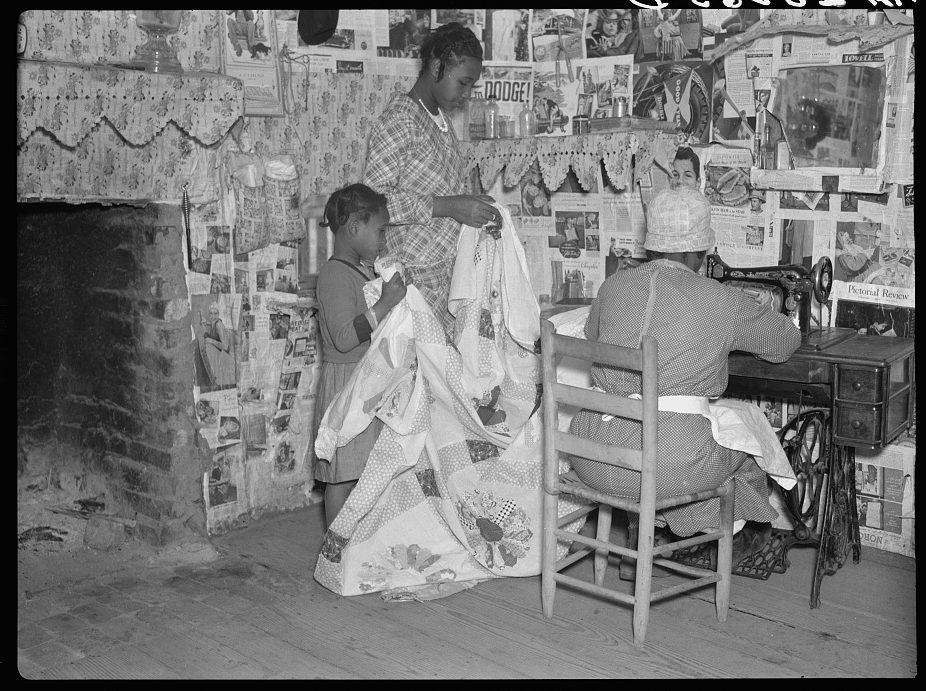 Arthur Rothstein, photographer. Sewing a quilt. Gees Bend, Alabama 1939, Library of Congress
Arthur Rothstein, photographer. Sewing a quilt. Gees Bend, Alabama 1939, Library of Congress Gee’s Bend, later named Boykin, is located southwest of Selma, Alabama. The area is not only rural but isolated. Bounded on three sides by the Alabama River, Gee’s Bend was once home to numerous cotton plantations named after their owners, including Gee, Bennett, Pettway, and Irby. Many of the quilters were and are direct descendants of enslaved Africans who took the surnames of these plantation owners. Living in unheated shacks, Gee’s Bend women made quilts for warmth and utility. Drawing upon aesthetic legacies, creative vision, and patterns from the world around them, these quilters have constructed some of the most iconic textiles of the African American South.
"My grandmama, Prissy Pettway, told me, 'You better make quilts. You going to need them.'... I needed them to keep warm."
- Loretta Pettway
As a child, Linda Diane Bennett (1955-1988) learned to quilt from her grandmother, Delia Bennett, and mother, Ella Mae Irby. Born in Gee’s Bend into a community of quilters, Bennett quickly embraced the tradition and continued it even while working as a deputy sheriff at the nearby Camden courthouse. Her mother fondly remembered her daughter’s quiet resolve, sitting alone “piecing” quilts on her lap will into the evenings after work. Piecing a quilt is a process where fabric pieces are sewn together to form a block, garment or quilt. Linda Bennett created stellar works of art using remnants of clothing and corduroy brought home by her mother and grandmother, who participated in the Freedom Quilting Bee cooperative for Sears, Roebuck and Company in the 1970s.
Six of the quilts in VMFA’s collection are Sears Roebuck & Co. quilts including works by Ruth Kennedy (1926-2020), Loretta Pettway (b. 1942) and Louella Pettway (1921-2006). The project was developed to bring jobs to the area, and many local quilters signed on. In addition to jobs, however, the contract with Sears brought a new material to the quilters. The leftover scraps of fabric was used in more experimental ways at home. While some of these quilters worked on the Sears Roebuck initiative, others used scraps and remainders offered to them, creating quilts with a vibrant array of patterns and compositions.
Rita Mae Pettway (b. 1941) is often cited describing how she and her family made quilts together. In the evenings or on weekends, suspended frames would be lowered from the ceiling or walls to allow the family to continue their collective work on a quilt. Although each individual would piece together her own top, others would assist in the making of the full quilt.
“Piecing them up, you do that by yourself; but quilting, we all did that together.” – Rita Mae Pettway
Learn more about the Gee’s Bend community in this interview with Mary Pettway.
A quilt with concentric squares, or pieces radiating from the center, are following the “Housetop,” pattern which is popular within the Gee’s Bend tradition. The examples above demonstrate just two of the many variations on this pattern.
“Housetops” share the technique of joining rectangular strips of cloth so that the end of a strip’s long side connects to one short side of a neighboring strip, eventually forming a kind of frame surrounding the central patch; increasingly larger frames or borders are added until a block is declared complete.
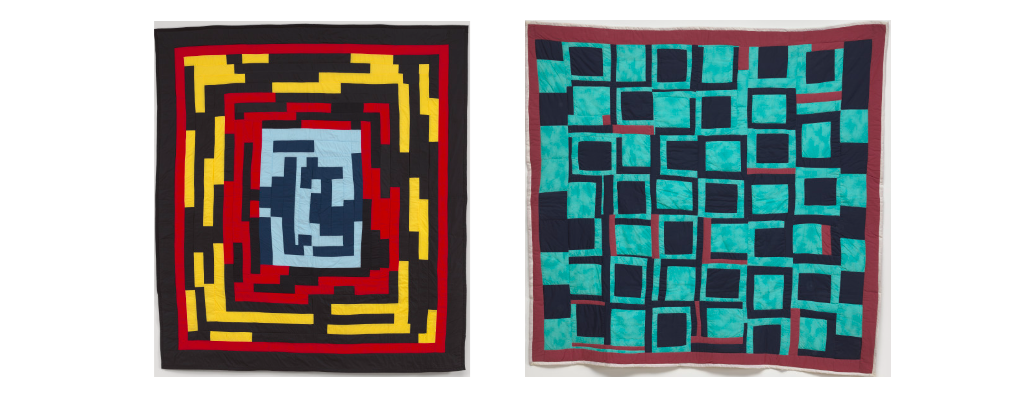
(left) “Housetop” variation, 2006, Mary Lee Bendolph (American, b. 1935), cotton. Virginia Museum of Fine Arts, Adolph D. and Wilkins C. Williams Fund and partial gift of the Souls Grown Deep Foundation from the William S. Arnett Collection, 2018.52; (right) “Houstop” variation, 2003, Louisiana Bendolph (American, b. 1960), cotton. Virginia Museum of Fine Arts, Adolph D. and Wilkins C. Williams Fund and partial gift of the Souls Grown Deep Foundation from the William S. Arnett Collection, 2018.51
 Mid to Late 20th Century Galleries, 2019
Mid to Late 20th Century Galleries, 2019 The Souls Grown Deep Foundation aims to reshape the narrative of contemporary American art history, shedding new light on the rich visual traditions of largely unknown African American artists and the ways in which their art further illuminates the social and political issues of their times. Through the acquisition of these quilts, VMFA has joined them in their mission to expand the narrative around modern and contemporary art.
VMFA is committed to including works by artists whose extraordinary talents were nurtured through informal educational frameworks such as familial traditions and social engagement rather than conventional art schools or university study. Since the acquisition in 2019, a new quilt has been featured in the Minimalism Galleries every eight months. This continual rotation is necessary given the fragility of the medium and offers new dialogue and insight with each quilt that is displayed in the space.
Nell Hall Williams was born near Gee’s Bend, where her mother, Pearlie Hall, was raised. Before she reached her teenage years, Williams was making her quilts from cast-off clothing and bleached flour sacks. After amassing a number of quilts as an adult, Williams lost most of them in a house fire. This quilt is one of the few remaining from this early period of the artist’s life. In her use of the “Stacked Bricks” pattern, Williams plays upon the silk’s lush texture to generate maximum visual effect. The composition of this work clearly displays her knowledge of color dynamics. Williams’s bold use of geometric forms brings a sense of improvisational movement to the work and offers a great visual exchange with Donald Judd’s Meter Boxes, seen to the left of this quilt.
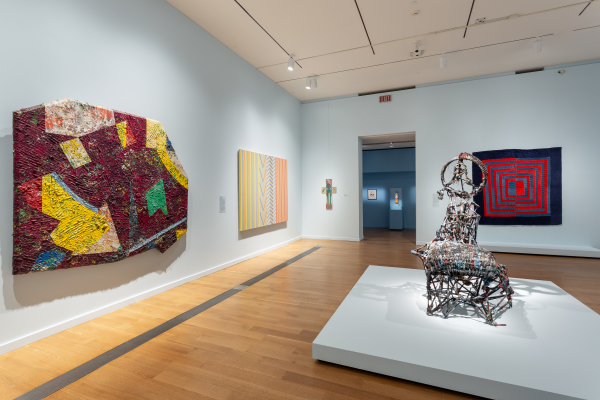 The Dirty South: Contemporary Art, Material Culture, and the Sonic Impulse exhibition, 2021.
The Dirty South: Contemporary Art, Material Culture, and the Sonic Impulse exhibition, 2021. VMFA’s special exhibition The Dirty South: Contemporary Art, Material Culture, and the Sonic Impulse (2021) which explored the art, music, and material culture of the African American South, and the ways these cultural expressions defined contemporary Black Southern sensibilities featured the work of Rita Mae Pettway (b. 1941).
In Pettway’s Housetop (featured in the image of the exhibition at left), the push and pull of the lines and color can be framed as “call and response,” a technique in music and religious worship that migrated through channels of the African Diaspora. With alternating colors, each side of this quilt seems to call back and forth to each other as the symmetry of the square is broken and misaligned. This willful misalignment of the pattern functions to trap evil, which was believed to travel in a straight line. Drawing upon aesthetic legacies, creative vision, and patterns from the world around them, these quilters have constructed some of the most iconic textiles of the African American South.
Explore The Dirty South Collection StoryThe Gee’s Bend Quilters are an active collective today hosting Quilting Retreats where they share their unique quilting styles as participants explore the work of their hands and the spirituality of quilting. For more information please visit Gee’s Bend Quilting Collective.